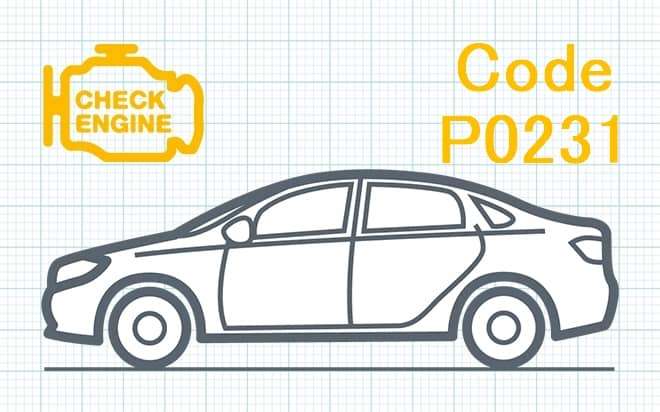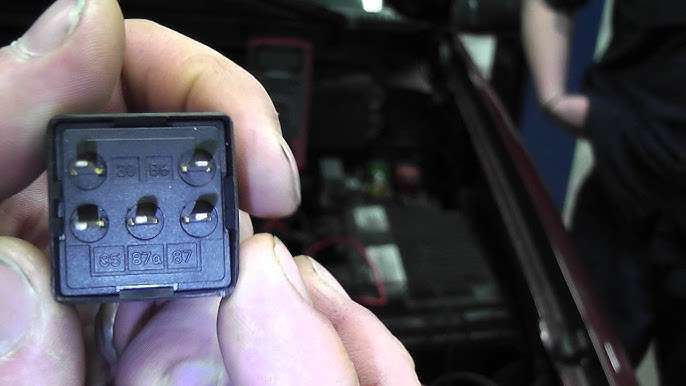
P0231 Low voltage of the secondary circuit of the fuel pump
Content
P0231 – OBD-II Trouble Code Technical Description
Trouble code P0231 indicates low fuel pump secondary circuit voltage.
What does the fault code mean P0231?
Trouble code P0231 usually means that the fuel pump secondary circuit is experiencing low voltage. This indicates problems with the electrical system that powers or controls the fuel pump.

Possible reasons
Some possible reasons for the P0231 trouble code:
- Poor electrical connection: Opens, short circuits or oxidation of wires or connectors associated with the secondary circuit of the fuel pump can cause low voltage.
- Faulty fuel pump: The fuel pump itself may be faulty, causing insufficient electrical voltage in the circuit.
- Faulty fuel pump relay: The relay that controls power to the fuel pump may be faulty or have poor contact, resulting in insufficient electrical voltage.
- Fuse problems: The fuses that power the fuel pump may be overheated, blown, or faulty.
- Problems with the electronic control unit (ECU): Faults in the ECU, which controls the fuel pump, can cause low voltage in the circuit.
- Damage to wiring or connectors: Physical damage to the wiring or connectors, such as due to mechanical stress or corrosion, can result in low voltage.
What are the symptoms of a fault code? P0231?
Trouble code P0231, which indicates low voltage in the fuel pump secondary circuit, may present with the following symptoms:
- Power Loss: One of the most common symptoms is loss of engine power. Insufficient voltage in the fuel pump circuit can result in insufficient or erratic fuel delivery, affecting engine performance.
- Slow or uneven acceleration: If the fuel pump does not receive enough voltage, it may result in slow or uneven acceleration when you press the gas pedal.
- Engine starting problems: Low voltage in the fuel pump circuit can affect the engine starting process, especially during cold starts. There may be a delay in starting or even the possibility of the engine being completely unable to start.
- Unstable idle: Insufficient voltage in the fuel pump circuit can cause the engine to idle rough, resulting in a shaking or rough idle.
- When a fault code appears: Typically, the engine management system detects the presence of low voltage in the fuel pump circuit and sets the P0231 trouble code. This may cause a Check Engine light to appear on your vehicle's dashboard.
If you experience these symptoms or trouble code P0231, it is recommended that you take it to a qualified mechanic or auto repair shop for diagnosis and repair.
How to diagnose a fault code P0231?
To diagnose DTC P0231, follow these steps:
- Checking fault codes: Use a car scanner to read trouble codes from the ECU (electronic control unit). Make sure the P0231 code is present and not random.
- Visual inspection: Inspect the wires and connectors associated with the fuel pump for damage, corrosion, or breaks.
- Voltage check: Using a multimeter, measure the voltage at the appropriate fuel pump pins or connectors with the ignition key in the on position.
- Checking relays and fuses: Check the condition of the relays and fuses that control power to the fuel pump. Make sure they are working properly and have no bad contacts.
- Checking the fuel pump itself: Check the fuel pump itself to ensure its functionality and integrity.
- ECU diagnostics: If necessary, diagnose the ECU to ensure that it correctly controls the fuel pump and responds correctly to changes in voltage.
- Additional tests: If necessary, perform additional tests, such as checking the grounding system or checking wiring integrity.
Diagnostic errors
When diagnosing the P0231 trouble code, various errors can occur which can lead to an incorrect or incomplete diagnosis of the problem, some common errors are:
- Incorrect interpretation of the code: One of the common mistakes is misunderstanding the essence of the P0231 code. It indicates low voltage in the secondary circuit of the fuel pump, and not a malfunction of the fuel pump itself. The error may be an incorrect diagnosis and replacement of the fuel pump when the problem may be in the electrical system or another component.
- Skipping Basic Checks: Poor diagnostics can result in missing important steps such as checking electrical connections, relays, fuses, and the fuel pump itself. This may lead to incorrect identification of the cause of the problem and incorrect repair.
- Faulty diagnostic equipment: Using faulty or uncalibrated diagnostic equipment may also result in incorrect diagnostic results.
- Ignoring other fault codes: Sometimes problems in the electrical system can cause multiple fault codes to appear. Ignoring other codes or focusing only on the P0231 code may cause you to miss additional problems.
- Incorrect repair priority: Code P0231 does not always mean that the fuel pump is faulty. This may be due to other problems such as a broken wire or a faulty relay. Therefore, it is important to correctly identify the cause of the low voltage and prioritize repairs accordingly.
To successfully diagnose and resolve the problem, it is recommended to conduct a comprehensive diagnosis and pay attention to detail. If you are unable to diagnose the problem yourself, it is best to contact a qualified mechanic or auto repair shop.
How serious is the fault code? P0231?
Several aspects to consider when assessing the severity of the P0231 code:
- Potential loss of power and performance: Low voltage in the fuel pump circuit can result in insufficient fuel flow to the engine, which can cause loss of power and performance.
- Risk of engine damage: Insufficient fuel in the engine can cause the engine to overheat or malfunction, which can ultimately lead to engine damage.
- Difficulty starting the engine: Insufficient voltage in the fuel pump secondary circuit can make it difficult to start the engine, especially during cold starts.
- Damage to other components: Low voltage in the fuel pump secondary circuit can cause other components in the fuel system to become unstable, which can ultimately lead to their damage.
- Potential Hazards: Failure to start the engine or improper operation due to low voltage in the fuel pump secondary circuit can create hazardous situations on the road.
So, trouble code P0231 should be taken seriously and the problem should be resolved as soon as possible to avoid further troubles. If you experience this trouble code, it is recommended that you take it to a qualified mechanic for diagnosis and repair.
What repair will help eliminate the code? P0231?
Resolving the P0231 trouble code may require several potential repair procedures depending on the source of the problem, some of which are:
- Checking and replacing the fuel pump: If the fuel pump is faulty or does not provide sufficient voltage, it should be checked and, if necessary, replaced. This may include replacing the entire pump or replacing individual components such as the pump module or relay.
- Checking and replacing electrical connections: Inspect the wiring and connectors associated with the fuel pump to ensure they are not broken, corroded, or have poor connections. Replace damaged components if necessary.
- Checking and replacing relays and fuses: Check the condition of the relays and fuses that control power to the fuel pump. If necessary, replace them with new ones.
- ECU diagnostics and repair: If the problem is not related to physical components, the electronic control unit (ECU) that controls the fuel pump may need to be diagnosed and repaired.
- Additional checks: Perform additional checks, such as checking the grounding system or diagnosing other fuel system components.
It is important to conduct a thorough diagnosis before proceeding with repairs to ensure that the problem is truly resolved. If you have no experience in car repairs or are unsure of your skills, it is recommended that you contact a qualified mechanic or auto repair shop.
P0231 – Brand-specific information
Trouble code P0231 can apply to different makes and models of vehicles, some definitions for some specific brands:
- Ford: P0231 – Fuel pump secondary circuit low voltage.
- Chevrolet: P0231 – Fuel pump secondary circuit low voltage.
- Volkswagen (Volkswagen): P0231 – High fuel pressure.
- Toyota: P0231 – Fuel pump secondary circuit low voltage.
- Honda: P0231 – Fuel pump secondary circuit low voltage.
These are just a few examples of how different manufacturers interpret the P0231 code. For more precise information about how a specific automaker interprets this code and what the possible causes and repair procedures may be, it is recommended that you consult the official repair or service manual for your specific make and model of vehicle.